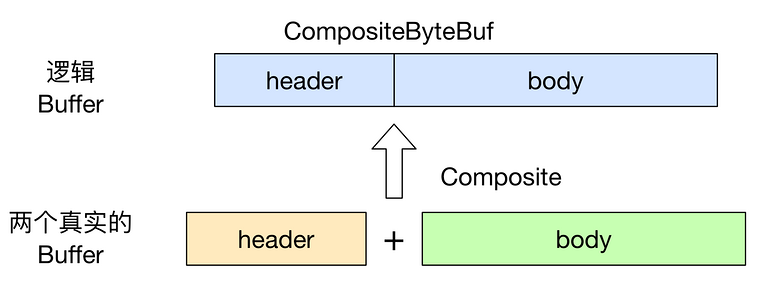Netty - ByteBuf
2019独角兽企业重金招聘Python工程师标准>>> 
1.ByteBuf类 - Netty的数据容器
ByteBuf维护了两个不同的索引:
- readerIndex:用于读取
- writerIndex:用于写入
起始位置都从0开始:

名称以read或者write开头的方法会更新ByteBuf对应的索引,而名称以set或者get开头的操作不会。 AbstractByteBuf#readByte 代码如下:
public byte readByte() {checkReadableBytes0(1);int i = readerIndex;byte b = _getByte(i);readerIndex = i + 1;// 这里更新了索引return b;
}
AbstractByteBuf#getByte 代码如下:
public byte getByte(int index) {checkIndex(index);return _getByte(index);// 直接返回,没有更新索引
}
2.ByteBuf的使用模式
(1)堆缓冲区
将数据存储在JVM的堆空间。
- 好处:提供快速分配和释放4
- 场景:遗留数据处理
public static void heapBuffer() {ByteBuf heapBuf = BYTE_BUF_FROM_SOMEWHERE; //get reference form somewhereif (heapBuf.hasArray()) { //检查 ByteBuf 是否有一个支撑数组byte[] array = heapBuf.array();//如果有,则获取对该数组的引用int offset = heapBuf.arrayOffset() + heapBuf.readerIndex();//计算第一个字节的偏移量int length = heapBuf.readableBytes();//获得可读字节数handleArray(array, offset, length);//使用数组、偏移量和长度作为参数调用你的方法}
}
如果hasArray()返回false,仍然去访问array()会抛出UnsupportedOperationException。
(2)直接缓冲区
NIO在JDK1.4中引入的ByteBuffer类允许JVM实现通过本地调用来分配内存。直接缓冲区的内容将驻留在常规的会被垃圾回收的堆之外。 如果数据包含在一个在堆上分配的缓冲区中,在通过套接字发送它之前,JVM会在内部把缓冲区复制到一个直接缓冲区中。
- 目的:避免在每次调用本地I/O操作之前(后)将缓冲区的内容复制到一个中间缓冲区(或者从中间缓冲区把内容复制到缓冲区)
- 缺点:直接缓冲区的分配和释放较堆缓冲区昂贵
public static void directBuffer() {ByteBuf directBuf = BYTE_BUF_FROM_SOMEWHERE; //get reference form somewhereif (!directBuf.hasArray()) {//检查 ByteBuf 是否由数组支撑。如果不是,则这是一个直接缓冲区int length = directBuf.readableBytes();//获取可读字节数byte[] array = new byte[length];//分配一个新的数组来保存具有该长度的字节数据directBuf.getBytes(directBuf.readerIndex(), array);//将字节复制到该数组handleArray(array, 0, length);//使用数组、偏移量和长度作为参数调用你的方法}
}
(3)复合缓冲区
为多个ByteBuf提供一个聚合视图,可以根据需要添加或者删除ByteBuf实例。 CompositeByteBuf ByteBuf的子类,提供一个将多个缓冲区表示为单个合并缓冲区的虚拟表示。CompositeByteBuf中的ByteBuf实例可能同时包含直接内存分配和非直接内存分配。

- 通过JDK的
ByteBuffer实现:创建一个包含两个ByteBuffer的数组来保存消息组件
public static void byteBufferComposite(ByteBuffer header, ByteBuffer body) {// Use an array to hold the message partsByteBuffer[] message = new ByteBuffer[]{ header, body };// Create a new ByteBuffer and use copy to merge the header and bodyByteBuffer message2 =ByteBuffer.allocate(header.remaining() + body.remaining());message2.put(header);message2.put(body);message2.flip();
}
- 使用
CompositeByteBuf实现的复合缓冲区模式:
public static void byteBufComposite() {CompositeByteBuf messageBuf = Unpooled.compositeBuffer();ByteBuf headerBuf = BYTE_BUF_FROM_SOMEWHERE; // can be backing or directByteBuf bodyBuf = BYTE_BUF_FROM_SOMEWHERE; // can be backing or directmessageBuf.addComponents(headerBuf, bodyBuf);//将 ByteBuf 实例追加到 CompositeByteBuf//...//删除位于索引位置为 0(第一个组件)的 ByteBufmessageBuf.removeComponent(0); // remove the header//循环遍历所有的 ByteBuf 实例for (ByteBuf buf : messageBuf) {System.out.println(buf.toString());}
}
- 因为
CompositeByteBuf可能不支持访问其支撑数组,访问CompositeByteBuf中的数据类似于直接缓冲区的模式:
public static void byteBufCompositeArray() {CompositeByteBuf compBuf = Unpooled.compositeBuffer();int length = compBuf.readableBytes();//获得可读字节数byte[] array = new byte[length];//分配一个具有可读字节数长度的新数组compBuf.getBytes(compBuf.readerIndex(), array);//将字节读到该数组中handleArray(array, 0, array.length);//使用偏移量和长度作为参数使用该数组
}
3.ByteBuf字节级操作
ByteBuf提供了许多超出基本读/写操作的方法用于修改数据。
(1)随机访问索引
第一个字节的索引:0, 最后一个字节的索引:capacity() - 1
public static void byteBufRelativeAccess() {ByteBuf buffer = BYTE_BUF_FROM_SOMEWHERE; //get reference form somewherefor (int i = 0; i < buffer.capacity(); i++) {byte b = buffer.getByte(i);System.out.println((char) b);}
}
(2)顺序访问索引
首先看下ByteBuf的内部分段:
+-------------------+------------------+------------------+| discardable bytes | readable bytes | writable bytes || | (CONTENT) | |+-------------------+------------------+------------------+| | | |0 <= readerIndex <= writerIndex <= capacity
After discardReadBytes():对可写分段的内容并没有任何保证,因为只是移动了可以读取的字节以及writerIndex,并没有对所有可写入的字节进行擦除写。
+------------------+--------------------------------------+| readable bytes | writable bytes (got more space) |+------------------+--------------------------------------+| | |readerIndex (0) <= writerIndex (decreased) <= capacity
可以看出,ByteBuf被读索引和写索引划分成了3个区域:
- 可丢弃字节:已经被读过的字节,调用
discardReadBytes()丢弃并回收空间(丢弃字节部分变为可写)。初始大小是0,存储在readerIndex中,随着read操作的执行而增加。 - 可读字节:可读字节分段存储了实际数据。新分配的/包装的/复制的缓冲区的默认的readerIndex值为0。任何
read或者skip开头的操作都将检索或者跳过位于当前readerIndex的数据,并且将它增加已读字节数。如果被调用的方法需要一个ByteBuf参数作为写入的目标,并且没有指定目标索引参数,那么该目标缓冲区的writerIndex也将被增加。如果尝试在缓冲区的可读字节数已经耗尽时从中读取数据,将抛出-IndexOutOfBoundsException见下面代码 - 可写字节:可写字节分段指一个未定义内容/写入就绪的内存区域。新分配的缓冲区的writerIndex的默认值是0。任何
write开头的操作都将从当前的writerIndex处开始写数据,并将它增加已经写入的字节数。
readBytes(ByteBuf dst) 代码
public ByteBuf readBytes(ByteBuf dst) {readBytes(dst, dst.writableBytes());return this;
}
public ByteBuf readBytes(ByteBuf dst, int length) {if (checkBounds) {if (length > dst.writableBytes()) {throw new IndexOutOfBoundsException(String.format("length(%d) exceeds dst.writableBytes(%d) where dst is: %s", length, dst.writableBytes(), dst));}}readBytes(dst, dst.writerIndex(), length);dst.writerIndex(dst.writerIndex() + length);return this;
}
如何读取所有可读字节:
public static void readAllData() {ByteBuf buffer = BYTE_BUF_FROM_SOMEWHERE; //get reference form somewherewhile (buffer.isReadable()) {System.out.println(buffer.readByte());}
}
如何往可写字节分段写数据:
public static void write() {// Fills the writable bytes of a buffer with random integers.ByteBuf buffer = BYTE_BUF_FROM_SOMEWHERE; //get reference form somewherewhile (buffer.writableBytes() >= 4) {buffer.writeInt(random.nextInt());}
}
转载于:https://my.oschina.net/javamaster/blog/2996702
Netty - ByteBuf相关推荐
- Netty ByteBuf(图解之 2)| 秒懂
目录 Netty ByteBuf(图解二):API 图解 源码工程 写在前面 ByteBuf 的四个逻辑部分 ByteBuf 的三个指针 ByteBuf 的三组方法 ByteBuf 的引用计数 Byt ...
- 对于 Netty ByteBuf 的零拷贝(Zero Copy) 的理解
根据 Wiki 对 Zero-copy 的定义: "Zero-copy" describes computer operations in which the CPU does n ...
- 【Netty4】netty ByteBuf (二) 引用计数对象(reference counted objects)
原文出处:http://netty.io/wiki/reference-counted-objects.html 相关文章: netty ByteBuf (一)如何创建ByteBuf对象 netty ...
- Netty——ByteBuf的API
ByteBuf 正如前面所提到的,网络数据的基本单位总是字节.Java NIO 提供了 ByteBuffer 作为它 的字节容器,但是这个类使用起来过于复杂,而且也有些繁琐. Netty 的 Byte ...
- Netty - ByteBuf索引管理
2019独角兽企业重金招聘Python工程师标准>>> 之前写过一篇文章介绍过JDK里面InputStream的mark(readlimit)和reset()方法,Java IO:使 ...
- netty ByteBuf对象池和内存泄漏检测实现走读
该文已重写,请移步: https://blog.csdn.net/weixin_40318210/article/details/108970208 https://blog.csdn.net/wei ...
- Netty中ByteBuf 的零拷贝
转载:https://www.jianshu.com/p/1d1fa2fe1ed9 此文章已同步发布在我的 segmentfault 专栏. 根据 Wiki 对 Zero-copy 的定义: &quo ...
- Netty 学习之旅:ByteBuf 篇之 ByteBuf 内部结构与 API 学习
1.原生 ByteBuffer.ByteBuf 内部结构设计 首先我们来回顾一下 java.nio.ByteBuffe r的内部结构设计. ByteBuffer 内部持有一个 byte[] bt, 再 ...
- Netty(九)——ByteBuf源码之析
ByteBuf在Netty占据着中重要的位置,上篇<Netty--ByteBuf功能之说>讲了ByteBuf的工作原理和重要功能介绍.这篇从源码的角度来看ByteBuf.首先,来看一下主要 ...
最新文章
- 浅谈Python中的编码规则
- jvm最大内存限制多少?
- gradle挂接到构建生命周期(七)
- iOS中如何优化Cell中图片的下载性能
- [JavaWeb-HTML]HTML概念介绍和快速入门
- 7-27 冒泡法排序 (20 分)
- UI设计素材|汉堡按钮/菜单
- 从数据库导出数为生成excel表
- du命令和df命令的区别
- 化解字符串不能超过8000的方法及交叉表的处理
- odoo stock库存模块
- cpu测试稳定性软件,测试CPU稳定性工具Prime95
- 抖音去水印java和js版本
- SSM SpringBoot vue快递柜管理系统
- VirtualBox 无法安装 已删除了注册表及文件
- 隐藏控件--HiddenField控件
- 现代交通灯的设计C语言编程,交通灯设计_优秀论文.doc
- Linux编译命令 make -j8 的意义
- 光彩夺目的30款太阳光线照射Ps笔刷
- 0055:手机话费(C++)
